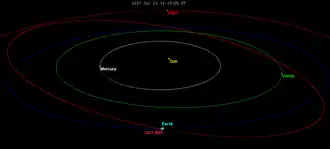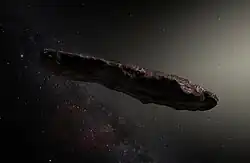2017 BS5
 July 23, 2017 flyby of Earth | |
| Discovery[1][2] | |
|---|---|
| Discovered by | ATLAS (T05) |
| Discovery site | Haleakala Obs. |
| Discovery date | 25 January 2017 |
| Designations | |
| 2017 BS5 | |
| Apollo · NEO[1] | |
| Orbital characteristics[1] | |
| Epoch 4 September 2017 (JD 2458000.5) | |
| Uncertainty parameter 1 | |
| Observation arc | (190 days) |
| Aphelion | 1.0231 AU |
| Perihelion | 1.0078 AU |
| 1.0154 AU | |
| Eccentricity | 0.0075 |
| 1.02 yr (374 days) | |
| 204.63° | |
| 0° 57m 47.52s / day | |
| Inclination | 11.232° |
| 120.84° | |
| 15.577° | |
| Earth MOID | 0.0070 AU · 2.7 LD |
| Physical characteristics | |
| Dimensions | 40–90 meters |
| 24.1[1] | |
In the astronomy of the Solar System, 2017 BS5 is a sub-kilometer asteroid, classified as near-Earth object that belongs to the Apollo group. It measures approximately 40–90 meters.[3] During a close approach to Earth, it was first observed 25 January 2017, by the ATLAS survey at Haleakala Observatory, Hawaii, United States.[2]
Orbit
2017 BS5 has a low-eccentricity orbit with a semi-major axis only slightly larger than that of Earth. It orbits the Sun at a distance of 1.008–1.023 AU once every 1.02 years (374 days). Its orbit has an eccentricity of 0.01 and an inclination of 11° with respect to the ecliptic.[1] It has an Earth minimum orbital intersection distance of 0.007 AU (1,050,000 km), which corresponds to 2.7 lunar distances.[1] The body is too small to be classified as a potentially hazardous asteroid.
July 2017 flyby
On 23 July 2017, it passed by within 3.15 lunar distances.[4] Seen from the Earth it passed straight north to south from Draco south into Scorpio. With its 1.023 year orbit it has a synodic period of 43 years with the earth, so it will flyby the Earth every 43 years or so. JPL Small-Body Database's simulator show the previous flyby in July 1973 and next one will be in July 2061.


References
- ^ a b c d e f "JPL Small-Body Database Browser: (2017 BS5)" (2017-07-23 last obs.). Jet Propulsion Laboratory. Retrieved 2 August 2017.
- ^ a b "2017 BS5". Minor Planet Center. Retrieved 2 August 2017.
- ^ "Five Known Asteroids Will Give Earth A Close Shave in The Coming Year". IFLScience. Retrieved 13 February 2020.
- ^ "Five asteroids will cruise by Earth in the next year, and one is coming very close".
External links
- MPEC 2017-B69 : 2017 BS5
- 2017 BS5 at NeoDyS-2, Near Earth Objects—Dynamic Site
- 2017 BS5 at the JPL Small-Body Database


